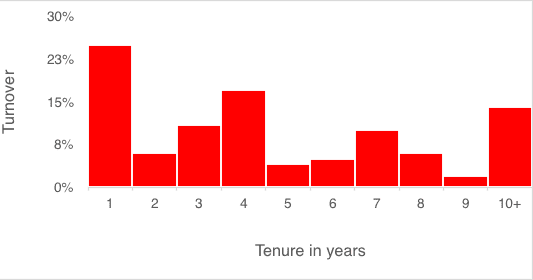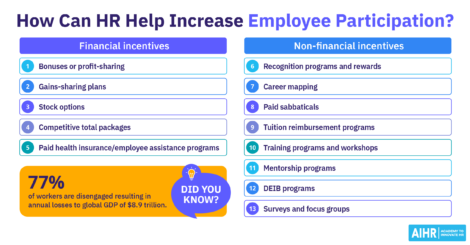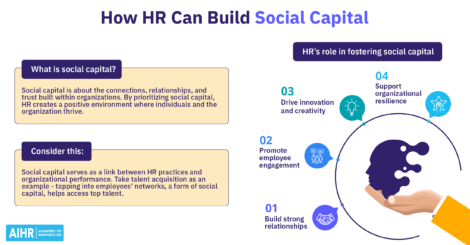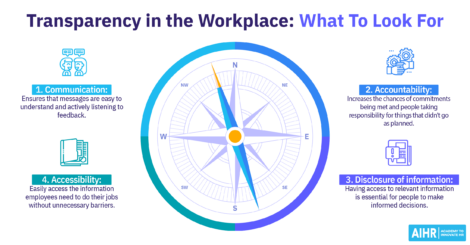How Employee Journey Mapping can Change the Employee Experience

The employee journey is receiving an increasing amount of attention from HR practitioners – and for good reason! In this article, I will explain what the employee journey is and how it can be leveraged for the benefit of the employee and the employer.
So, let’s get started.
Contents
What is the employee journey?
The employee journey from the employee’s perspective
Notable moments
Measuring the employee journey
The employee journey from the employer’s perspective
Employee journey mapping
Application and Conclusion
FAQ
What is the employee journey?
The employee journey is the time an employee spends at a company, starting when the employee applies to the organization and ending when the employee quits the organization. All the time in between these two moments and the experiences that the employee has is the employee journey.
Not all moments in the employee journey are the same. We all remember our first day at work – we don’t remember our second day. Identifying these ‘moments that matter’ is an important part of mapping the employee journey. This can be very helpful in improving the experience that employees have. We will talk about techniques to do this, later in this article.
Other examples of notable moments are the first job interview, the first day at work, the initial one-on-one with the manager, and the employee’s first performance review. These experiences – and many others – constitute the employee journey.
Let’s take a closer look at the employee journey from two perspectives: the employee’s perspective and the employer’s perspective. Both will give us valuable insights on how we can create a better journey – and the advantages that this will bring us.
The employee journey from the employee’s perspective
It’s Monday morning and it’s Jill’s first day at work. She is excited when she drives her car in the parking lot below the company’s headquarter. There are quite some cars driving in and the garage is already pretty full – with the exception of a few spots near the elevator.
“This is a great sign”, Jill thinks, “the best spot in the lot on my first day at work!” She parks her car and walks to the elevator when she hears hurried footsteps behind her.
“You must be the new colleague,” says the women in her mid-forties that ran up to her, “the parking spots near the elevator are reserved for the executives, it’s kind of an unwritten rule.”
Jill thanks her for the potentially career-saving tip walks back to the car and after descending to the lowest levels of the parking garage, finds a spot and heads up to her office.
After meeting her team, Jill walks over to the IT department to get her username and password. Slightly annoyed that this hasn’t been arranged yet, she impatiently waits as the IT service staff is joking around and showing each other internet memes while creating Jill’s user account.
25 minutes later she’s back in her office and excited to log in. After starting her computer, a message prompts: “Installing Windows updates, 1/72 updates”.
Jill sighs and thinks “This is going to be a long day”.
Notable moments
As I wrote in the introduction, there are a number of notable moments in the employee journey. As Jill’s story illustrates, the first day is surely one of them with multiple of those moments. Identifying these ‘moments that matter’ is an important first step in understanding the full employee journey. Other moments are:
- The first job interview
- The first day at work
- The first one-on-one with the direct manager
- The first full performance review
- Other activities that are an important part of the onboarding process
- The employee’s birthday
- Training activities
- Team events
- Company restructurings
- Exit interview
…and many other moments that are different from day-to-day work, especially if these also have a long-term impact on the employee or his/her position.
These ‘moments that matter’ don’t have to be major events. Someone recently told me about an internal survey they did asking what employees remembered most in the past year. In that company, a few colleagues were diagnosed with breast cancer so the company had created a small breast cancer awareness event for everyone.
This small event that took only a few hours meant more to most employees than all the other HR activities. Sometimes it’s the little things that matter most.
Measuring the employee journey
A good way to measure the effectiveness of the employee journey is through the employee experience. The employee experience is how employees feel about what they encounter and observe over the course of their employee journey at an organization.
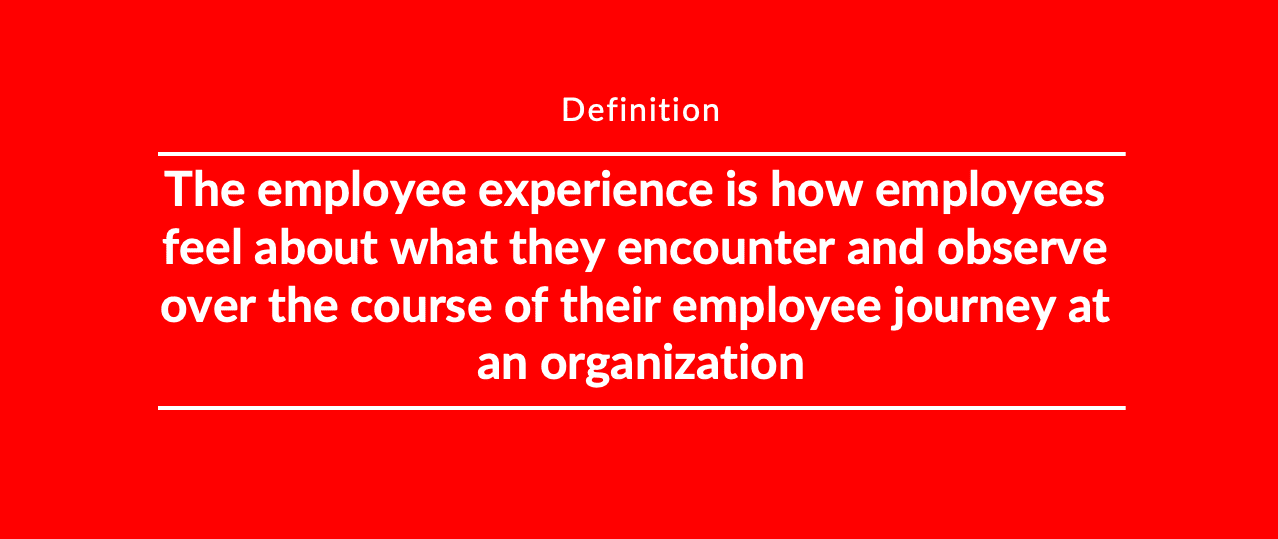
This subjective feeling is very important. In our example, Jill doesn’t have a good first few hours. Her employee experience will, therefore, be lower compared to when parking policies were communicated well, her username and password had been ready and her computer was updated in advance.
I propose that the employee experience is a good way to measure how the employee journey is organized. By measuring this experience, companies can assess the strong and weak points in the journey and improve these.
The employee journey from the employer’s perspective
My second proposition is that the ‘moments that matter’ for the employee are also the ones that matter for the employer. If the employee has a bad experience in their first weeks on the job, the chances of this person leaving the company in the first year increase drastically. This is disadvantageous for the employer.
In other words: the key experiences for employees are also the ones the employer wants to measure and monitor. By doing this, the employer has a thermometer that is predictive of the value that the employee will create for the company.
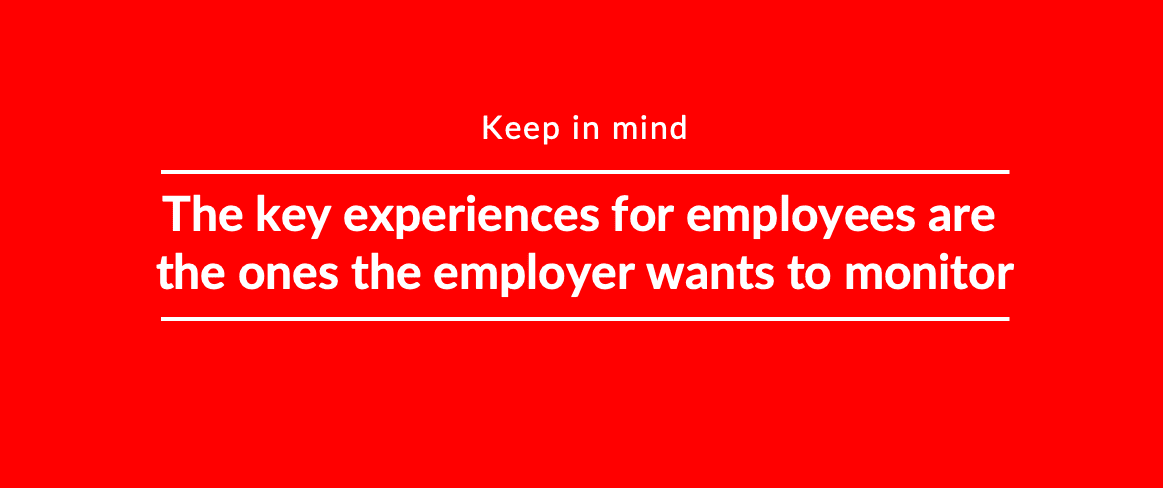
This means that measuring the employee experience at the right points in the employee journey has an advantage for both the employee and the employer.
Employee journey mapping
Identifying the most important points in the employee journey for your organization can be done through a technique called employee journey mapping. The objective is to identify and chronologically list the ‘moments that matter’ for the employee.
This technique first takes a quantitative approach. What does your employee data tell you? If you already have exit interview data, this can be very helpful. Measuring at which points employees become disengaged, or even quit the company can also be very helpful.
Below you will find a plot of turnover by years of tenure. What do you notice when you look at the data?
There is a high turnover in the first year. The first-year turnover is an indication of bad onboarding practices and can be predicted by a low employee experience in the first day, week, and month of the employee journey.
In addition, there is a peak in turnover around year 3 and 4, which could be an indication of a lack of internal promotion opportunities, and another peak in year 7, which could be another indication of a lack of movement in the company after having made the first career move. From year 7 onward, turnover goes down, with the rest of the turnover happening after 10 or more years.
Using this quantitative data can help to form a number of hypotheses of why turnover increases at these points – and this is valuable input for the next step.
In the second step of mapping the employee journey, you use this quantitative data input for a number of conversations with employees. Ask employees what they found the most important moments in their journey.
A good technique is to focus on multiple distinct groups:
- Talk to people who left very early on, who score very low on engagement scales, or who are known as ‘complainers’. These people usually thought well about their situation and decision to leave and can thus identify and express the ‘moments that matter’ much more clearly than others.
- Talk to the people who are top performers within the first year of working with you and who stayed very long. It’s usually the groups at the extreme ends of the spectrum that know very well why they like or don’t like to work at the organization.
- Talk to experienced line managers. Especially the very skilled managers already manage and optimize the employee journey to a large extent. This helps them to get people motivated and engaged. They can be a very valuable source of information in mapping the employee journey.
Application and conclusion
Once you have mapped the employee journey and you do measure the employee experience at the ‘moments that matter’, what’s the next step? There are a few solutions that can help you provide a streamlined and positive employee journey.
- The moments that matter are the ones you want to streamline. If onboarding is important, consider investing in an onboarding app that checks whether all the important criteria for successful onboarding have been met. Did the employee have the first one-on-one with the manager? Are expectations for the job well-defined and communicated to the employee? Has the employee met the entire team within the first day of working at the company? And so on. The app helps to remind and track how many of these ‘moments that matter’ have taken place. I expect there to be a direct correlation between this goal-completion and the employee experience.
A technique to measure the employee experience at the right time could be a pulse survey, or a simple email asking about the employee experience. These pulses or emails should then be sent during those ‘moments that matter’ (e.g. just after a performance review has taken place). - With this measurement structure in place, you can measure the impact of better employee practices. To stick to onboarding: if you implement such an app, you expect the employee experience to increase for the next cohort of new hires that are using this app. If the experience remains the same, it’s an indication that the app is not used or ineffective. If the experience goes down, you need to review your process.
- If you have the data, measure how the employee experience at these ‘moments that matter’ correlates with absence, productivity, engagement, and the intention to leave the company. As this is a fairly new approach, I haven’t been able to find quantitative validation of this method yet.
For further reading, I would suggest Volker Jacob’s article on this platform on the Customer Experience of HR and his other works on the employee experience.
FAQ
The employee journey is all the time and experiences an employee has at a company, starting when they apply to the organization and ending when they leave the organization.
The employee experience is a good way to measure how the employee journey is organized. By measuring this, companies can assess the strong and weak points in the journey and improve these.
Identifying the most important points in the employee journey for your organization can be done through employee journey mapping. The objective is to identify and chronologically list the ‘moments that matter’.
Weekly update
Stay up-to-date with the latest news, trends, and resources in HR
Learn more
Related articles
Are you ready for the future of HR?
Learn modern and relevant HR skills, online





